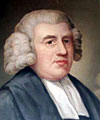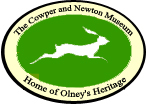|
THE MUSEUM PEOPLE
WORKS ORCHARD SIDE GARDENS |
 |
|
The Cowper and Newton Museum
|
|
|

This well known and well loved hymn contains unmistakable references to Newton's early life and experiences, particularly his conversion to Christianity following his miraculous survival from a storm in 1748. It all began one morning in about 1772 when the curate of Olney Church took as his text the opening words of David's prayer in 1 Chronicles chapter 17:
Then he explained to his audience how David had come to this point in his life. Praising God for His care, His mercy and forgiveness, and His provision for the future. And all of that to one so insignificant, so unworthy. Reflecting upon the preserving grace of God to him in his turbulent seafaring days, Newton wrote a poem for that meeting to illustrate the gist of his message. He called it ‘Faith's Review and Expectation'. It went like this:
As he presented his latest hymn to the congregation that morning, neither the author of it, nor those who learnt it verse by verse, could have had the slightest inkling as to how God, in His wonderful wisdom, was set to use this simple song about His amazing grace in the years to come. Newton did not write any music for his hymn, as at that time in the established Church, hymns were chanted rather than sung. Furthermore, as the congregation in general could not read, they were encouraged to learn the words of the hymns by rote. Although written in a small English town, this hymn was initially not well known in England, and does not appear in any of the earlier hymnbooks except for 'The Olney Hymns' which was first published in 1779. It was in America that it became established. The Americans did two things for it. The first was that they set it to the tune of an old plantation melody entitled 'Loving Lambs'. That tune is the one we now know so well as 'Amazing Grace'. The other was the substitution of a final verse beginning 'When we’ve been there ten thousand years'. This latter was the final verse of the anonymous hymn ‘Jerusalem, my happy home’ found in ‘A Collection of Sacred Ballads’ compiled by Richard and Andrew Broaddus published in 1790. Until the time of his death in 1807 at the age of 82, John Newton never ceased to marvel at God's mercy and grace that had so dramatically changed his life. This was the dominant theme of his preaching and writing. Shortly before his death a spokesman for the church suggested that he (Newton) consider retirement because of failing health, eyesight and memory. Newton replied, "What? Shall the old African blasphemer stop while he can still speak?". On other web sites: On this web site |
|
|
